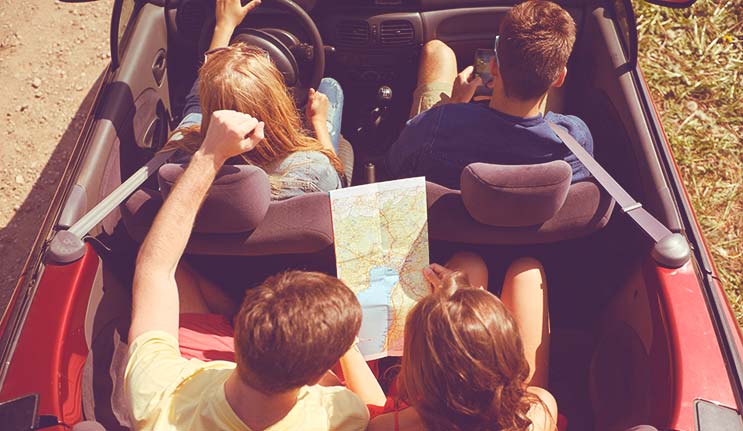In late October I packed up everything I could fit into my compact car in Upstate, New York and logged over 3,600 miles to settle down in sunny San Diego. I grew up loving road trips and explored just about every area that was under an 8-hour drive from my hometown. Prior to my move in 2014 I flew to Seattle to drive back to New York, and I had been itching to drive across the country again ever since. When it was time to decide on flying or driving to my new city I already had my heart set on an epic road trip, so there wasn’t much that anyone could say to convince me to change my mind.
I’m not sure how many times you have to make the 3,000-mile trek before you can consider yourself an expert, but after 2 times across the country I’ve learned a lot about what to expect. If you’re thinking about planning a long-distance road trip this upcoming travel season, there are a few important things you will want to consider before you leave.
Safety
It’s probably not hard for everyone to come up with a list of people they know that fear air travel. However, the odds of dying on an airplane are 1 in 11 million, and the odds of dying in a car accident are 1 in 5,000. In addition to this, Lafayette car accident attorneys Brandt & Sherman have found that over 2 million people are injured in car accidents every year.
Before you leave it’s incredibly important to have your car serviced. I made sure to get an oil change, new windshield wipers, tires and air filters, and had a full safety inspection of my car completed before I left. It is good to remember that you’ll be experiencing many different elevation changes, and the weather could change dramatically over the course of just one day. We drove through Yellowstone National Park towards the end of May and experienced blizzard-like conditions and sunny green meadows on the same day on different sides of the park.
You should always pack an emergency kit for the unexpected. It should include the basics such as jumper cables, flares and a first aid kit. For longer trips I always include a blanket, water bottles, snacks, and if you’re going to be traveling into areas that might have snow you will need a snow brush and a shovel.
Technology
If you’re anything like me growing up in New York we all rely on technology for just about everything. One of the first lessons I learned, especially the farther away you get from either coast, is that you will not have much access to cell service or internet while you’re on the road. Once we left Seattle our phones were pretty much useless to us other than to use as a camera until we made it closer to Chicago.
I would recommend having an old-fashioned GPS and hard copies of maps. We also started to look for free WiFi signs which is where we would pull over to search for hotels and places to eat if we needed to. You might not have your cell phone to call for help if you’re in an accident while you’re on the road so be prepared to flag someone down or walk to the nearest town.
Plan Ahead
The biggest thing I cannot stress enough is that if you’re driving across the Midwest and see a gas station, you should stop if your tank is anywhere close to a half a tank. I think we nearly ran out of gas two or three times before we learned this the hard way. You might think you’ve been driving through enough small towns every few miles so you don’t have to worry about it. That is exactly when we found ourselves on a 100-mile stretch of road without a single gas station in sight.
Keep your planning to a minimum so you feel like you’re being spontaneous, but have goals to hit at the same time. This becomes incredibly important if you do not have flexibility in how many days your trip will take. On my first trip, we only booked a hotel for the first night. Each night after we stopped when it felt like we couldn’t drive any farther. On the second trip, we booked every hotel ahead of time spacing them out anywhere from 5 to 10 hours of driving time between them. This way we knew exactly how far we needed to travel each night so that we would hit our deadline for arriving in California.
The Centers for Disease Control and Prevention found that 1 in 25 drivers has most likely fallen asleep behind the wheel in the past 30 days. It might be tempting to cram in long days of driving so that you can get to your must-see destinations quickly, but you need to make sure you’re getting enough rest. Tests have shown that someone who is driving while makes similar mistakes to someone who is under the influence of alcohol. One of my favorite memories was a break we took in Wyoming where I believe the road sign stated the town had a population of less than 20 people. The best part of a road trip is getting to see the less-traveled areas along the way. Take advantage of these stops for both the experience they provide and the chance to take a break from driving.
Wherever you decide to travel to this summer, be safe, and enjoy the drive!
 Ericka Murray grew up in Albany, New York where she earned degrees in Communications and Art History while attending the University at Albany. She loves to travel and recently settled down in San Diego, California to work as a public relations specialist.
Ericka Murray grew up in Albany, New York where she earned degrees in Communications and Art History while attending the University at Albany. She loves to travel and recently settled down in San Diego, California to work as a public relations specialist.



